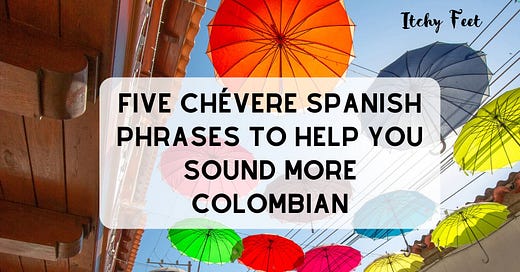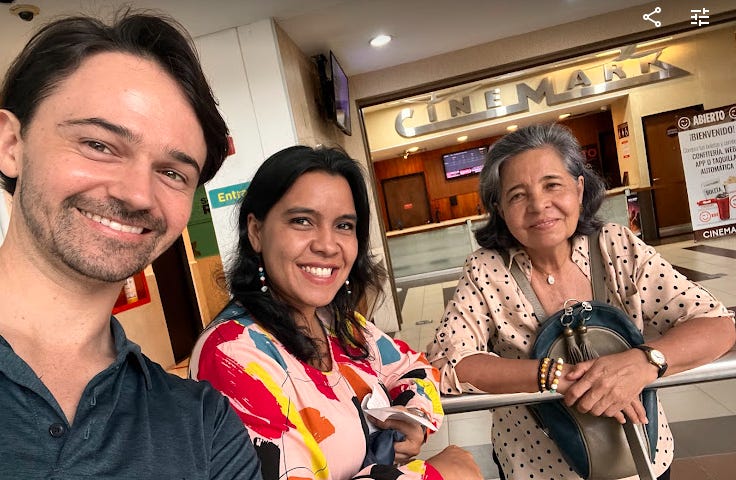Five Chévere Spanish Phrases to Help You Sound More Colombian
and details about Colombian culture that surprised me.
Hey friend! Thank you for reading! This week’s edition of Itchy Feet will be a little different.
I’m changing it up this week in honor of this newsletter reaching 100 subscribers!
Thank you for being here and helping this publication take off! ✈️ 🙏
Last week we talked about how to avoid being an unaware tourist. You can read about it here.
This edition is about something just as important…
I want to talk about one of my favorite countries: Colombia. 🇨🇴
A little extra about me: I’m currently writing this post in Neiva, Colombia.
I spend 6 months a year here to visit my girlfriend Yesi and her mom Piedad. For the past two years, Colombia has become my second home.
It’s been a whirlwind experience, full of great memories, plenty of culture shock, and everything in between.
Colombia is a wonderful country and I highly recommend you visit!
Before coming to Colombia, I thought I knew Spanish pretty well. I was surprised at how many dichos (sayings) and new vocabulary Colombia has. Despite being the same language spoken in other countries like Spain and Mexico, Colombian Spanish is a different beast.
Here is a brief guide of some chévere (cool) phrases to help you speak like a Colombian:
Please note: I’m basing this on Spanish from Neiva, which might be different than other regions in the country.
Also, most of these phrases used the formal or “usted” verb conjugation. In Neiva, this verb form is common for many interactions regardless of age.
“Dar Papaya”

This isn’t necessarily a phrase you need to say, but it’s a phrase you should understand.
When I came to Neiva for the first time, Yesi’s family reminded me to never “dar papaya.” This translates to “give papaya.”
At first, I thought, “I’d absolutely love some papaya! Where do I sign up?”
Papaya is a delicious fruit found in supermarkets throughout Colombia. When you are “giving papaya” it has nothing to do with food: it means you’re letting your guard down.
In Colombia, when you let your guard down, it’s easier to attract unwanted attention.
Here are some examples of “giving papaya.”
Walking in public with your phone out.
Wearing a fancy watch around town.
Taking out your wallet to find cash on a busy street.
In a nutshell, it means to be safe and aware of your surroundings.
¿Qué Más?

If you are looking to greet a Colombian, you can get by in most places with “¿Qué más?” which is the Colombian way of saying “What’s up?”
Note #1: I learned Colombian greetings usually involve at least three questions.
“¿Como le ha ido?” (how have you been?), “¿Que cuenta?” (what do you say?) and “¿Que hubo?” (Neiva people’s unique version of “¿qué más?) are common greeting combinations.
You don’t have to answer all three. I like to respond “Muy bien, gracias. ¿y usted?”
Note #2: In Neiva, almost everyone says “¿como ameneció?” which means “how are you this morning?”
I don’t know if other regions of Colombia do the same. “Hola, ¿como ameneció?” is a great way to greet people.
“Hagáme un favor”
This translates to “do me a favor.” For some reason, asking for favors is a normal way to ask for things in Colombia.
When you need to ask a question like “Where is D street?” to a stranger, it’s best practice to say “do me a favor” before asking.
In Colombia, it sounds more polite to ask this way. It also increases the likelihood the person you ask will help (colaborar).
It’s like a way of warming someone up before you ask for help.
“Con Permiso”

Colombians are some of the pilotest people you’ll ever meet. If you don’t reciprocate with good manners, people will think you lack culture or respect.
You will hear simple phrases like “con permiso” everywhere you go.
This phrase is useful to move around someone, by two people blocking a door, or use the bathroom in a group setting.
The literal translation is “with permission,” but it really means “excuse me.”
I’ve learned better manners in Colombia.
“Regálame un _________, por favor”
This phrase is popular when you order something at a store, restaurant, or coffee shop.
“Regálame” means “give me.” Because “regalar” means to “give a gift,” I was confused. It sounded like everyone wanted a free gift.
But in Colombia, people don’t take it that way.
A waiter or shop clerk understands we don’t want the bottle of water for free.
It’s a way of saying “I’d like ______ please.” They’d understand you want the item and are planning on spending money.
However, in non-paying situations, you can use the same phrase.
For example, imagine a server just delivered your lunch but didn’t give you a spoon.
You can say:
“Regálame una cuchara (spoon), por favor.”
In this situation, this person knows you’re not looking to buy the spoon. Rather, you just need one.
You don’t have to request things this way, but it’s what I commonly hear whenever I go places in Colombia.
Bonus #1: “Paila”

This is one of the most fun Colombian slang words I learned.
Simply put, “paila” means “too bad” or “that sucks.” You can say it as a standalone word and people know what you mean.
If you miss the bus…“paila.”
Did you not get the job?….“pues (well), paila.”
It’s used in the context of something that’s beyond repair, saving, or correcting.
If a person makes a huge mistake and they can’t ever make amends for their error, you can even say to them:
“Estás paila.”
Bonus #2: “Berraco”
My favorite second Colombian slang words is “Berraca/o.” It’s one of the most versatile vocabulary words I’ve discovered so far in Colombia.
You can use the word in so many ways, which I love. For example:
Marta es una berraca (Marta is awesome at a certain activity)
Marta es berraca (Marta is brave)
Marta está berraca (Marta is angry)
Esté problema está berraco (this is a really tough problem)
Tu carro es para berracos (Your car is for brave people)
I originally shared this article on my personal blog, There Dan Was.
Thanks for reading! I hope you enjoyed this different-style post. Next week I’ll have a regular post and an Inspiration Postcard (for premium members!).
I appreciate you! 😊
Take care!
-Daniel
More articles you might like:
• What are Travel Planning Templates? (Freebie Alert)
• 9 Ways to Not Be an Ignorant Tourist When You Travel
• How I Learned a Second Language (and you can too!)
Looking for travel planning help?
• Get a personalized travel guide for the place you’re going!








Good one Daniel! Love all the phrases/slang of Colombia. And how cool that you live there 6 months a year. It looks like a beautiful country. What region-area are you in? I'm not familiar w/ it.
Thanks for these tips as my husband and I will be in Colombia soon. I think I will skip learning Regálame as we will be traveling to other countries and I don't want anyone to think im asking for a gift. Hagáme sounds really useful. I hear Con Permiso a lot in Mexico when people pass you in the grocery store.